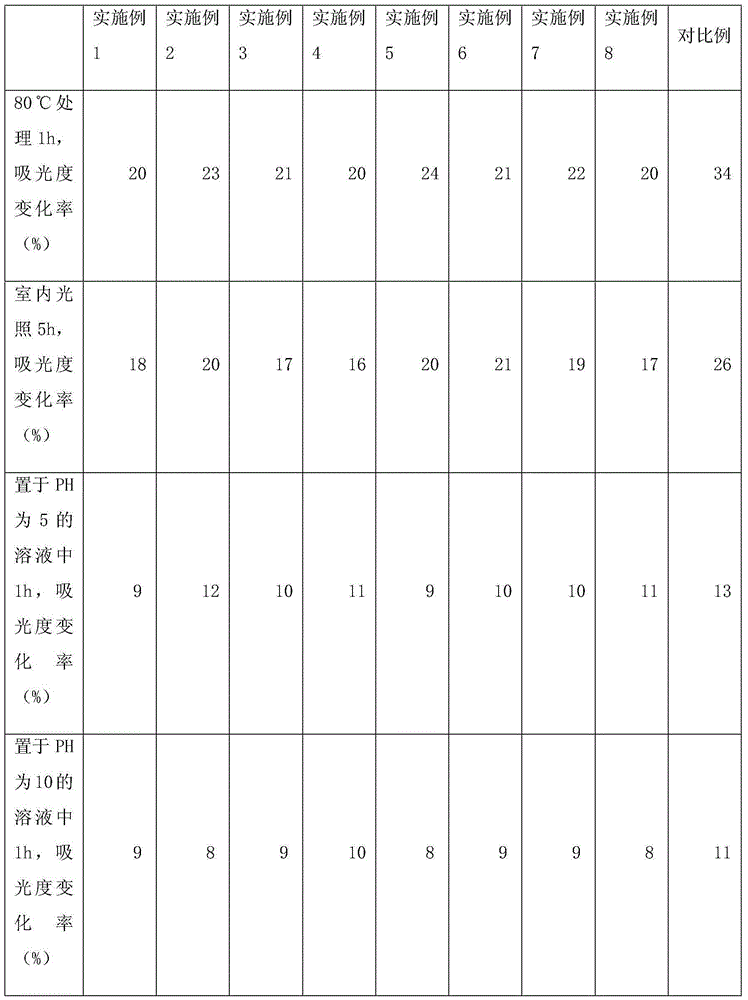Novel Chinese rose pigment applicable to textile dyes and preparation method thereof
A technology for textile dyes and rose flowers, applied in the direction of azo dyes, organic dyes, natural dyes, etc., can solve the problems of little improvement in the stability of rose anthocyanins and rare dye applications, and achieve simple and quick extraction methods and bright colors , the effect of less impurities
- Summary
- Abstract
- Description
- Claims
- Application Information
AI Technical Summary
Problems solved by technology
Method used
Image
Examples
Embodiment 1
[0028] (1) Wash the fresh rose petals with tap water to remove obvious dirt, then rinse with distilled water, dry them with filter paper, dry them in an oven at 35°C, grind them, and screen them through an 80-mesh sieve to form powdery rose petals .
[0029] (2) In parts by weight, place 1 part of the powdered Chinese rose prepared in step (1) in 30 parts of hydrochloric acid ethanol solution, wherein the content of hydrochloric acid is 30%, ultrasonically treat for 30 minutes under 200W power, and filter to obtain Filtrate, the filtrate is concentrated with a vacuum rotary evaporator, and dried to obtain a paste-like rose anthocyanin.
[0030] (3) In parts by weight, place 1 part of the paste-like rose anthocyanin prepared in step (2) in 50 parts of citric acid solution with a pH value of 5, add 20 parts of metal chelating agent, and stir evenly. Add 5 parts of anhydrous aluminum chloride, oscillate in an air bath until the reaction is complete, cool to room temperature, fil...
Embodiment 2
[0032] (1) Wash fresh rose petals with tap water to remove obvious dirt, then rinse with distilled water, dry with filter paper, dry in an oven at 45°C, grind, and sieve through a 100-mesh sieve to form a powdery rose flower .
[0033] (2) In parts by weight, place 1 part of the powdered Chinese rose prepared in step (1) in 100 parts of hydrochloric acid ethanol solution, wherein the content of hydrochloric acid is 50%, ultrasonically treat for 50min at 250W power, and filter to obtain Filtrate, the filtrate is concentrated with a vacuum rotary evaporator, and dried to obtain a paste-like rose anthocyanin.
[0034] (3) In parts by weight, place 80 parts of citric acid solution with a pH value of 6 of the paste-like rose anthocyanin prepared by 1 part of step (2), add 40 parts of metal chelating agent, after stirring evenly, Add 20 parts of anhydrous aluminum chloride, oscillate in an air bath until the reaction is complete, cool to room temperature, filter, and extract with p...
Embodiment 3
[0036] (1) Wash the fresh rose petals with tap water to remove obvious dirt, then rinse with distilled water, dry them with filter paper, dry them in an oven at 40°C, grind them, and screen them through a 90-mesh sieve to form powdery rose petals .
[0037] (2) In parts by weight, place 1 part of the powdered Chinese rose prepared in step (1) in 50 parts of hydrochloric acid ethanol solution, wherein the content of hydrochloric acid is 40%, ultrasonically treat for 40min under 230W power, and filter to obtain Filtrate, the filtrate is concentrated with a vacuum rotary evaporator, and dried to obtain a paste-like rose anthocyanin.
[0038] (3) In parts by weight, place 60 parts of citric acid solutions with a pH value of 5.5 of 1 part of the paste-like rose anthocyanin prepared in step (2), add 30 parts of metal chelating agents, and stir evenly. Add 15 parts of anhydrous aluminum chloride, oscillate in an air bath until the reaction is complete, cool to room temperature, filt...
PUM
 Login to View More
Login to View More Abstract
Description
Claims
Application Information
 Login to View More
Login to View More - R&D
- Intellectual Property
- Life Sciences
- Materials
- Tech Scout
- Unparalleled Data Quality
- Higher Quality Content
- 60% Fewer Hallucinations
Browse by: Latest US Patents, China's latest patents, Technical Efficacy Thesaurus, Application Domain, Technology Topic, Popular Technical Reports.
© 2025 PatSnap. All rights reserved.Legal|Privacy policy|Modern Slavery Act Transparency Statement|Sitemap|About US| Contact US: help@patsnap.com

